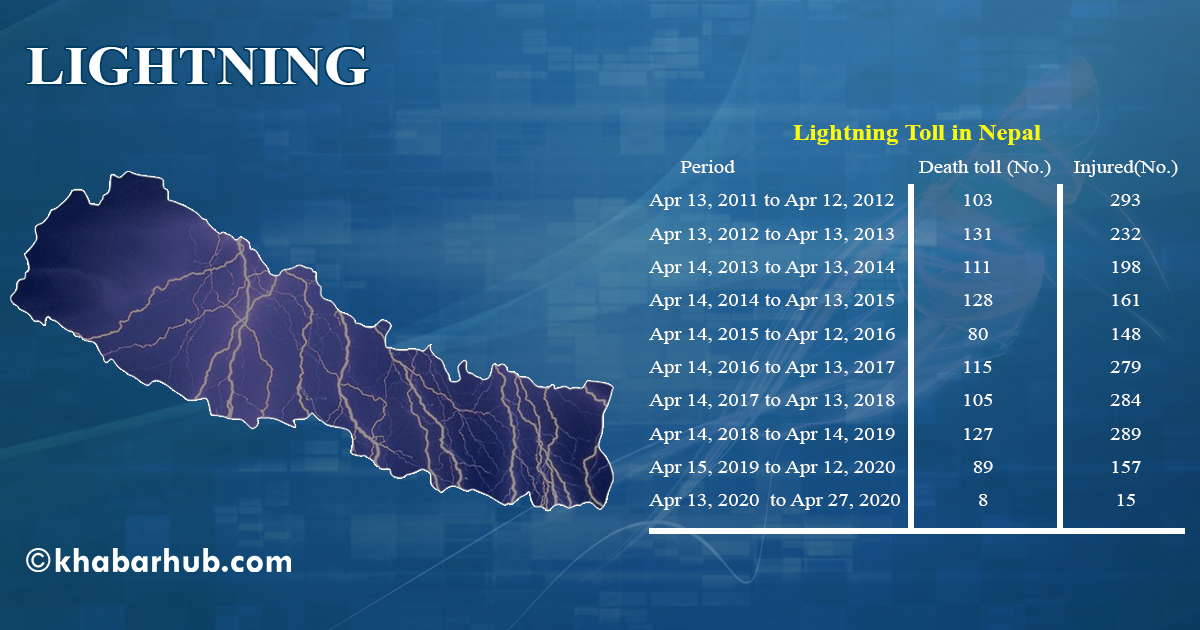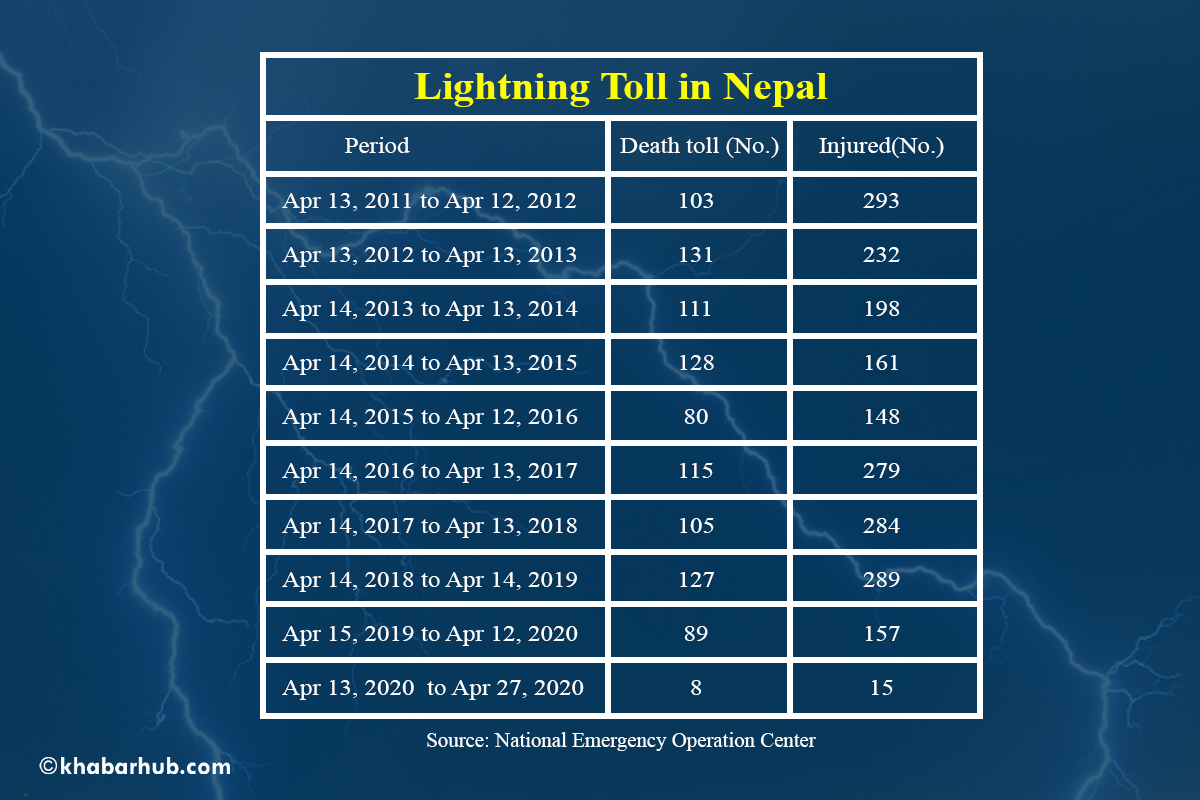0%

Image for Representation
KATHMANDU: Nepal is exposed to various types of natural disasters every year. The number of people losing their lives in disasters in the country is increasing every year.
With the arrival of pre-monsoon, lightning’s deadly grip is taking the lives of many people. Lightning kills more people than any other disaster every year.
According to the Ministry of Home Affairs, lightning accounts for the highest number of deaths from disaster in Nepal.
According to the National Emergency Operation Center, lightning has taken 8 lives and injured 15 in since April 13 this year.
Laxmi Khati, 7, of Shailya Shikhar Municipality-6, Tikhadhar was struck to death by lightning on April 14. According to Inspector Surendra Prasad Joshi of District Police Office, Darchula, 5 others were injured in the incident.
Chaitra Praja, 41, of Raksirang-3, Dhirang, Makawanpur died of thunderbolt on April 15. Three have died in the same ward.
Kalpana Bhusal, 28, of Phalewas Municipality, Tari, Parvat was killed by lightning on April 20. Similarly, two people died in Thakre, Dhading on April 21. Likewise, seven people were injured in Dhading lightning. Ujali Bayadi, 22, of Sayal-3, Toleni, Doti died of a bolt of lightning on the same day.

Lightning took lives of Bijuli Khatri, 55, of Dudhila Bhati Baglung and Anita Shah, 25, of Thati Baguda, Achham on April 22 and April 26 respectively. Two people were injured badly in the incident.
The list of people affected by the thunderbolt is long.
According to the National Emergency Operation Center, more than 100 people die every year because of lightning.
“Lightning is the gravest disaster killing more than any other disasters in Nepal,” Kedar Nath Sharma, the spokesperson of the Ministry of Home Affairs said.
NEOC’s nine years record shows that 1,042 people have died and 2,056 have been injured of lightning from April 13, 2011 to April 27, 2020.
Officials at NEOC say more than 24,000 people die of lightning across the world every year.
Nepal at high risk of lightning
In fact, lightning is the occurrence of natural electrical discharge of very short duration and high voltage between a cloud and the ground or within a cloud, accompanied by a bright flash and typically also thunder.
Mostly, the shocking electric waves are likely to fall on the ground during monsoon or pre-monsoon time.
According to a lightning expert, Professor Dr. Shree Ram Sharma, lightning occurs due to the friction in clouds when pre-monsoon or monsoon wind becomes active.
According to Suraj Baidya, the Director-General of the Department of Hydrology and Meteorology, when such electric waves fall on the ground, they cause damage.
Generally, lightning occurs in a thundercloud also called a cumulonimbus cloud during a thunderstorm. It is an electrical discharge from the cloud base to the ground.
Often lightning occurs between clouds or inside a cloud. When it goes from clouds to the ground, it becomes fatal to the beings that come in its route.
As the storm moves over the ground, the strong negative charges in the cloud attract positive charges in the ground. These positive charges move up into the tallest objects like trees, telephone poles, and houses.
It’s like a sudden electric explosion. It often occurs between Apr. to June, the pre-monsoon period.
According to Prof. Sharma, Nepal is in one of the three most vulnerable regions from the lightning risks point of view.
“Besides Africa, Nepal has the highest death toll from lightning,” he told Khabarhub.
According to him, Congo is the most vulnerable region of the world in terms of lightning. Venezuela and the area around South America and the areas stretching from Indonesia, Malaysia, in Southeast Asia to Nepal and the Bay of Bengal are also highly vulnerable.
How to stay safe from Lightning?
According to Prof. Dr. Sharma, the best safety measure against the damage by lightning is precaution.
Safety measures differ from place to place. One should adopt right measures as per one’s location. A person is either at home or outside, precautionary measures differ as per one’s location.
During the thunderstorm and rainfall, one should adopt special precautions. One should not stay near or under the tall and lonely tree.
As a precaution, one should abstain from the water area and should avoid swimming, fishing, rafting on such occasions.
While at home, one should adopt the measure like avoiding the use of electric appliances like TV, computer, fridge, etc.
One should not use the telephone or mobile, should not go out from home, and should not take a bath. Even when one should take a bath, one should use the bucket water.
Washing clothes or cleaning utensils should be postponed as well.
In other measures, there are precautions like shutting the doors and windows, staying away from the walls. The devices directly connected to electric wire, tv cable, and antenna should be disconnected and the use of electric appliances should be avoided at any cost.
Meteorologist Raju Dhar Pradhananga advises not to stay outside once the thunder starts.
“One should not stay at an open field, one should not lie on the ground, mass activities should be avoided,” Pradhananga suggests, “If there are the games like football, cricket, golf going on during such time, they should be stopped at once.”
The cattle should be taken to a safer place as well.